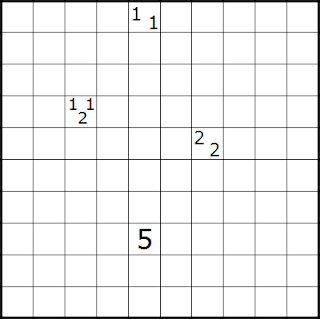The first puzzle is a Different Tapa. I took a bit of time to find a nice workable layout that didn't use the same shapes as the WPC puzzle and Robert Volmert's puzzle. I think layout looks nice and gave me enough room to place clues, while the shapes do interact. It took me a while to write this puzzle as I couldn't find a way to make it both unique and having a solution. In the end I managed to move 2 clues around, which finally made it unique. It's a tricky puzzle and you'll need to use the shape from early on in the solve to make progress.
The second puzzle is a Dissected Tapa. These are never too hard. Yin Yang is a good genre to practise for these puzzles.
The third puzzle is a Not Alone Tapa. I'm not sure about this genre. It seems very limiting as this 5 clue puzzle will show. For example, you can't have any T-shapes in the wall unless it's next to a clue cell.
The fourth puzzle is a Black Hole Tapa. I like the change that was made from the original instructions in the booklet. Having the count for the black hole and the amount of black holes both be variables can lead to completely different puzzle. I went for three black holes of value 2, which I think worked out well.
The last puzzle is a 4x4 Tapa. This puzzle somehow worked out this way with only 2 clues per 10x10 grid. There's a lot of things you need to take into account with this genre and I think this puzzle will help teach most of those things. It's important to think of the global picture to understand which deductions to make.
I hope all of this is helpful. Enjoy.
[Edit: wrong clue in Black Hole Tapa fixed]
Puzzles can be found below.
Rules for Tapa
6. Different Tapa
Follow standard Tapa rules. Additionally, each outlined region must have a different combination of black and white cells.
 |
| Click to enlarge |
7. Dissected Tapa
Follow standard Tapa rules. Additionally, form two congruent shapes, one of black cells and one of white cells. Clue cells count as white cells. Two shapes are congruent if they have the same size and shape, barring reflection and rotation.
 |
| Click to enlarge |
8. Not Alone Tapa
Follow standard Tapa rule. Additionally, a black cell can't lie between two white cells and vice versa. Clue cells don't count as black or white cells in this puzzle.
 |
| Click to enlarge |
9. Black Hole Tapa
Follow standard Tapa rules. Additionally, some coloured cells contain black holes. These black holes count as 2 consecutively shaded cells. Each row and column must contain exactly 3 black holes. Black holes are allowed to touch each other.
 |
| Click to enlarge |
10. 4x4 Tapa
Follow standard Tapa rules. Additionally, among the 4 grids each coordinate must be coloured exactly once, such that each grid forms a valid Tapa wall.
 |
| Click to enlarge |
You weren't kidding about Not Alone being limiting. I like the 4x4 Tapa most from these, Black Hole Tapa was fun too.
ReplyDeleteGreat puzzles. But are you sure that Black Hole is fixed? I can't find any way to distribute 12 black holes in the top four rows without completely ruining connectivity.
ReplyDeleteIt looks okay to me. If you want you can send me a picture of what you have to bram.d.laat[at]gmail[dot]com and I can compare what you have with my solution.
Delete4*4 is tough but fun puzzle! But I wonder if I try this one in the contest, because it must take lots of time.
ReplyDeleteHello Bram, thank you very much for these practice puzzles, I really learned a lot! And I enjoyed even puzzle types that first didn't sound like much fun for me, so for the Black Holes and Not Alone.
ReplyDeleteSilke